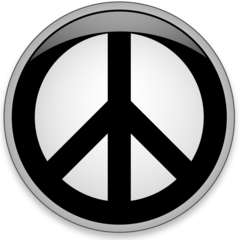World peace, or peace on Earth, is the concept of an ideal state of happiness, freedom and peace within and among all people and nations on Planet Earth. This idea of the world non-violence is one motivation for people and nations to willingly cooperate, either voluntarily or by virtue of a system of governance that has this objective. Different cultures, religions, philosophies, and organizations have varying concepts on how such a state would come about.
Various religious and secular organizations have the stated aim of achieving world peace through addressing human rights, technology, education, engineering, medicine, or diplomacy used as an end to all forms of fighting. Since 1945, the United Nations and the five permanent members of its Security Council (China, France, Russia, the United Kingdom and the United States) have operated under the aim to resolve conflicts without war or declarations of war. None the less, nations have entered numerous military conflicts since then.
World peace theories
Many theories as to how world peace could be achieved have been proposed. Several of these are listed below.
Peace through strength
The term is traced back to the Roman Emperor Hadrian (reigned AD 117 – 138) but the concept is as old as recorded history. In the Indian Epic Ramayana, considered 7000 years old, Lord Rama is quoted as saying "Bhay Bin Hoye na Preet" meaning once prayers for peace fail, one may need to instill fear to bring peace. In 1943, at the peak of World War II, the founder of the Paneuropean Union, Richard von Coudenhove-Kalergi, argued that after the war the United States is bound to take "command of the skies" to ensure the lasting world peace:
But the inauguration of such a glorious century of peace demands from us abandonment of old conceptions of peace. The new Angel of Peace must no longer be pictured as a charming but helpless lady with an olive branch in her hand, but like the Goddess of Justice with a balance in her left and a sword in her right; or like the Archangel Michael, with a fiery sword and wings of steel, fighting the devil to restore and protect the peace of heaven.
In fact, near the entrance to the headquarters of the SAC at Offutt Air Force Base stands a large sign with a SAC emblem and its motto: "Peace is our profession." The motto "was a staggering paradox that was also completely accurate". One SAC Bomber—Convair B-36—is called Peacemaker and one inter-continental missile-LGM-118-Peacekeeper.
In 2016, former US Secretary of Defense Ash Carter envisaged that the rebalance to the Asia-Pacific will make the region "peaceful" through "strength":
You, and your fellow soldiers, sailors, airmen, and Marines will solidify the rebalance, you will make this network work, and you will help the Asia-Pacific ... realize a principled and peaceful and prosperous future. And play the role only America can play ... You'll do so with strength.
Introduction to US National Security and Defense Strategies of 2018 states: The US force posture combined with the allies will "preserve peace through strength". The document proceeds to detail what "achieving peace through strength requires".
Associated with peace through strength are concepts of preponderance of power (as opposed to balance of power), hegemonic stability theory, unipolar stability, and imperial peace (such as Pax Romana, Pax Britannica, or Pax Americana).
Marxism: World peace via world revolution
According to the dialectic materialist theory of Karl Marx, humanity under capitalism is divided into just two classes: the proletariat - who do not possess the means of production, and the bourgeoisie - who do possess the means of production. Once the communist revolution occurs and consequently abolishes the private propriety of the means of production, humanity will not be divided and the tension created between these two classes will cease. Through a period called socialism, the rule of the proletariat will dissolve the last vestiges of capitalism and will help to make the revolution worldwide. Once private propriety has been abolished worldwide, the state will no longer be needed to act as a monopoly of violence and will therefore disappear. Organizations of workers will take their place and manage the production of things, but no organization will have any military power, a police force, nor prisons.
The main principle of Marx's theory is that material conditions limit spiritual conditions. Should their material conditions allow it, people around the world will not be violent but respectful, peaceful, and altruistic. In a state of communism, they will no longer need to live for survival, but for their own spiritual fulfillment.
Leon Trotsky argued that a proletariat world revolution would lead to world peace.
Democratic peace theory
Proponents of the democratic peace theory claim that strong empirical evidence exists that democracies never or rarely wage war against each other.
There are, however, several wars between democracies that have taken place, historically.
Capitalism peace theory
In her essay "The Roots of War", Ayn Rand held that the major wars of history were started by the more controlled economies of the time against the freer ones and that capitalism gave mankind the longest period of peace in history—a period during which there were no wars involving the entire civilized world—from the end of the Napoleonic wars in 1815 to the outbreak of World War I in 1914, with the exceptions of the Franco-Prussian War (1870), the Spanish–American War (1898), and the American Civil War (1861–1865), which notably occurred in perhaps the most liberal economy in the world at the beginning of the industrial revolution.
Cobdenism
Proponents of Cobdenism claim that by removing tariffs and creating international free trade wars would become impossible because free trade prevents a nation from becoming self-sufficient, which is a requirement for long wars.
However, free trade does not prevent a nation from establishing some sort of emergency plan to become temporarily self-sufficient in case of war or that a nation could simply acquire what it needs from a different nation. A good example of this is World War I, during which both Britain and Germany became partially self-sufficient. This is particularly important because Germany had no plan for creating a war economy.
More generally, free trade—while not making wars impossible—can make wars, and restrictions on trade caused by wars, very costly for international companies with production, research, and sales in many different nations. Thus, a powerful lobby—unless there are only national companies—will argue against wars.
Mutual assured destruction
Mutual assured destruction is a doctrine of military strategy in which a full-scale use of nuclear weapons by two opposing sides would effectively result in the destruction of both belligerents. Proponents of the policy of mutual assured destruction during the Cold War attributed this to the increase in the lethality of war to the point where it no longer offers the possibility of a net gain for either side, thereby making wars pointless.
United Nations Charter and international law
After World War II, the United Nations was established by the United Nations Charter to "save successive generations from the scourge of war which twice in our lifetime has brought untold sorrow to mankind" (Preamble). The Preamble to the United Nations Charter also aims to further the adoption of fundamental human rights, to respect obligations to sources of international law as well as to unite the strength of independent countries in order to maintain international peace and security. All treaties on international human rights law make reference to or consider "the principles proclaimed in the Charter of the United Nations, recognition of the inherent dignity and of the equal and inalienable rights of all members of the human family is the foundation of freedom, justice and "peace in the world".
Globalization
Gordon B. Hinckley saw a trend in national politics by which city-states and nation-states have unified and suggests that the international arena will eventually follow suit. Many countries such as China, Italy, the United States, Australia, Germany, India, and Britain have unified into single nation-states with others like the European Union following suit, suggesting that further globalization will bring about a world state.
Self-organized peace
World peace has been depicted as a consequence of local, self-determined behaviors that inhibit the institutionalization of power and ensuing violence. The solution is not so much based on an agreed agenda, or an investment in higher authority whether divine or political, but rather a self-organized network of mutually supportive mechanisms, resulting in a viable politico-economic social fabric. The principal technique for inducing convergence is thought experiment, namely backcasting, enabling anyone to participate no matter what cultural background, religious doctrine, political affiliation, or age demographic. Similar collaborative mechanisms are emerging from the Internet around open-source projects, including Wikipedia, and the evolution of other social media.
Economic norms theory
Economic norms theory links economic conditions with institutions of governance and conflict, distinguishing personal clientelist economies from impersonal market-oriented ones, identifying the latter with permanent peace within and between nations.
Throughout most of human history, societies have been based on personal relations: individuals in groups know each other and exchange favors. Today in most lower-income societies hierarchies of groups distribute wealth based on personal relationships among group leaders, a process often linked with clientelism and corruption. Michael Mousseau argues that in this kind of socio-economy conflict is always present, latent or overt, because individuals depend on their groups for physical and economic security and are thus loyal to their groups rather than their states, and because groups are in a constant state of conflict over access to state coffers. Through processes of bounded rationality, people are conditioned towards strong in-group identities and are easily swayed to fear outsiders, psychological predispositions that make possible sectarian violence, genocide, and terrorism.
Market-oriented socio-economics are integrated not with personal ties but the impersonal force of the market where most individuals are economically dependent on trusting strangers in contracts enforced by the state. This creates loyalty to a state that enforces the rule of law and contracts impartially and reliably and provides equal protection in the freedom to contract – that is, liberal democracy. Wars cannot happen within or between nations with market-integrated economies because war requires the harming of others, and in these kinds of economies, everyone is always economically better off when others in the market are also better off, not worse off. Rather than fight, citizens in market-oriented socio-economies care deeply about everyone's rights and welfare, so they demand economic growth at home and economic cooperation and human rights abroad. In fact, nations with market-oriented socio-economies tend to agree on global issues and not a single fatality has occurred in any dispute between them.
Economic norms theory should not be confused with classical liberal theory. The latter assumes that markets are natural and that freer markets promote wealth. In contrast, Economic norms theory shows how market-contracting is a learned norm, and state spending, regulation, and redistribution are necessary to ensure that almost everyone can participate in the "social market" economy, which is in everyone's interests. One proposed mechanism for world peace involves consumer purchasing of renewable and equitable local food and power sources involving artificial photosynthesis ushering in a period of social and ecological harmony known as the Sustainocene.
Nonkilling Global Political Science
Nonkilling, popularized in the 2002 book Nonkilling Global Political Science by Glenn D. Paige, builds on nonviolence theory and encompasses the concepts of peace (absence of war and conditions conducive to war), nonviolence (psychological, physical, and structural), and ahimsa (noninjury in thought, word and deed). Nonkilling provides a distinct approach characterized by the measurability of its goals and the open-ended nature of its realization. It can be quantified and related to specific causes, for example by following a public health perspective (prevention, intervention and post-traumatic transformation toward the progressive eradication of killing).
International Day of Peace
The International Day of Peace, sometimes called World Peace Day, is observed annually on 21 September. It is dedicated to peace, and specifically the absence of war and violence, and can be celebrated by a temporary ceasefire in a combat zone. The International Day of Peace was established in 1981 by the United Nations General Assembly. Two decades later, in 2001, the General Assembly unanimously voted to designate the day as a day of preventing violence and a cease-fire. The celebration of this day is recognized by many nations and people. In 2013, for the first time, the day has been dedicated to peace education, i.e. by the key preventive means to reduce war sustainably.
Religious views
Many religions and religious leaders have expressed a desire for an end to violence.
Baháʼí Faith
The central aim of the Baháʼí Faith is the establishment of the unity of the peoples of the world. Bahá'u'lláh, the founder of the Baháʼí Faith, stated in no uncertain terms, "the fundamental purpose animating the Faith of God and His Religion is to safeguard the interests and promote the unity of the human race ..." In his writings, Bahá'u'lláh described two distinct stages of world peace – a lesser peace and a sense of most great peace.
The lesser peace is essentially a collective security agreement between the nations of the world. In this arrangement, nations agree to protect one another by rising up against an aggressor nation, should it seek the usurpation of territory or the destruction of its neighbors. The lesser peace is limited in scope and is concerned with the establishment of basic order and the universal recognition of national borders and the sovereignty of nations. Baháʼís believe that the lesser peace is taking place largely through the operation of the Divine Will and that Baháʼí influence on the process is relatively minor.
The greatest peace is the eventual end goal of the lesser peace and is envisioned as a time of spiritual and social unity – a time when the peoples of the world genuinely identify with and care for one another, rather than simply tolerating one other's existence. The Baháʼís view this process as taking place largely as a result of the spread of Baháʼí teachings, principles, and practices throughout the world. The larger world peace process and its foundational elements are addressed in the document The Promise of World Peace, written by the Universal House of Justice.
Buddhism
Many Buddhists believe that world peace can only be achieved if individuals establish peace within their minds first. The Buddha's teachings emphasize that anger and other negative states of mind are the cause of wars and fighting. Buddhists believe people can live in peace and harmony only if they abandon negative emotions such as anger and cultivate positive emotions such as loving-kindness and compassion. As with all [[Dharmic religions],] (Hinduism, Jainism, Buddhism, and Sikhism), ahimsa (avoidance of violence) is a central concept.
Hatred is never appeased by hatred in this world. By non-hatred alone is hatred appeased. This is a law eternal.
— Siddhārtha Gautama, The Dhammapada: Pairs Verse 5
Peace pagodas are monuments that are built to symbolize and inspire world peace and have been central to the peace movement throughout the years. These are typical of Buddhist origin, being built by the Japanese Buddhist organization Nipponzan Myohoji. They exist around the world in cities such as London, Vienna, New Delhi, Tokyo, and Lumbini.
Christianity
The basic Christian ideal specifies that peace can only come by the Word and love of God, which is perfectly demonstrated in the life of Christ:
Peace I leave with you; my peace I give you. I do not give to you as the world gives. Do not let your hearts be troubled and do not be afraid.
As christologically interpreted from Isaiah 2, whereupon the "Word of the Lord" is established on the earth, the material human-political result will be 'nation not taking up sword against nation; nor will they train for war anymore'. Christian world peace necessitates the living of a proactive life replete with all good works indirect light of the Word of God. The details of such a life can be observed in the Gospels, especially the historically renowned Sermon on the Mount, where forgiving those who do wrong things against oneself is advocated among other pious precepts.
However, not all Christians expect a lasting world peace on this earth:
Do not suppose that I have come to bring peace to the earth. I did not come to bring peace, but a sword. For I have come to turn a man against his father, a daughter against her mother, a daughter-in-law against her mother-in-law—a man's enemies will be the members of his own household.
Many Christians believe that world peace is expected to be manifest upon the "new earth" that is promised in Christian scripture such as Revelation 21.
The Roman Catholic religious conception of "Consecration of Russia", related to the Church's high-priority Fátima Marian apparitions, promises a temporary world peace as a result of this process being fulfilled, though before the coming of the Antichrist. This period of temporary peace is called the triumph of the Immaculate Heart.
Hinduism
Traditionally, Hinduism has adopted an ancient Sanskrit phrase Vasudhaiva kutumbakam, which translates as "The world is one family". The essence of this concept is the observation that only base minds see dichotomies and divisions. The more we seek wisdom, the more we become inclusive and free our internal spirit from worldly illusions or Maya. World peace is hence only achieved through internal means—by liberating ourselves from artificial boundaries that separate us all. As with all [[Dharmic religions],] (Hinduism, Jainism, Buddhism, and Sikhism), ahimsa (avoidance of violence) is a central concept.
Islam
According to Islamic eschatology, the whole world will be united under the leadership of imam Mahdi. At that time love, justice and peace will be so abundant that the world will be in the likeness of paradise.
Judaism
The concept of Tikkun olam (Repairing the World) is central to modern Rabbinic Judaism. Tikkun Olam is accomplished through various means, such as ritualistically performing God's commandments, charity, and social justice, as well as through example persuading the rest of the world to behave morally. According to some views, Tikkun Olam would result at the beginning of the Messianic Age. It has been said that in every generation, a person is born with the potential to be the spiritual Messiah. If the time is right for the Messianic Age within that person's lifetime, then that person will be the Mashiach. But if that person dies before he completes the mission of the Messiah, then that person is not the Messiah (Mashiach).
Specifically, in Jewish messianism it is considered that at some future time a Messiah (literally "an anointed King appointed by God") will rise up to bring all Jews back to the Land of Israel, and to establish God's Torah, followed by everlasting global peace and prosperity. This idea originates from passages in the Old Testament and the Talmud.
For Torah will go forth from Zion and the Word of HaShem from Jerusalem. And He will judge between the nations and decide disputes for many peoples, and they will beat their swords into plowshares and their spears into pruning hooks; nation will not lift the sword against nation, neither will they learn war anymore.
Jainism
Compassion for all life, human and non-human, is central to Jainism. They have adopted the wordings of Lord Mahavira Jiyo our Jeeno Do. Human life is valued as a unique, rare opportunity to reach enlightenment; to kill any person, no matter what crime he may have committed, is considered unimaginably abhorrent. It is a religion that requires monks and laity, from all its sects and traditions, to be vegetarian. Some Indian regions, such as Gujarat, have been strongly influenced by Jains and often the majority of the local Hindus of every denomination have also become vegetarian. Famous quote on world peace as per Jainism by a 19th-century Indian legend, Virchand Gandhi: "May peace rule the universe; may peace rule in kingdoms and empires; may peace rule in states and in the lands of the potentates; may peace rule in the house of friends and may peace also rule in the house of enemies." As with all Dharmic religions (Hinduism, Jainism, Buddhism, and Sikhism), ahimsa (avoidance of violence) is a central concept.
Sikhism
Peace comes from God. Meditation, the means of communicating with God, is unfruitful without the noble character of a devotee, there can be no worship without performing good deeds. Guru Nanak stressed now kirat karō: that a Sikh should balance work, worship, and charity, and should defend the rights of all creatures, and in particular, fellow human beings. They are encouraged to have a chaṛdī kalā, or optimistic – resilience, view of life. Sikh teachings also stress the concept of sharing—vaṇḍ chakkō—through the distribution of free food at Sikh gurdwaras (laṅgar), giving charitable donations, and working for the good of the community and others (sēvā). Sikhs believe that no matter what race, sex, or religion one is, all are equal in God's eyes. Men and women are equal and share the same rights, and women can lead to prayers. As with all Dharmic religions (Hinduism, Jainism, Buddhism, and Sikhism), ahimsa (avoidance of violence) is a central concept.
Economic implications
A report in June 2015 on the Global Peace Index highlighted that the impact of violence on the global economy reached US$14.3 trillion. The report also found that the economic cost of violence is 13.4% of world GDP, equal to the total economic output of Brazil, Canada, France, Germany, Spain, and the UK combined.


















